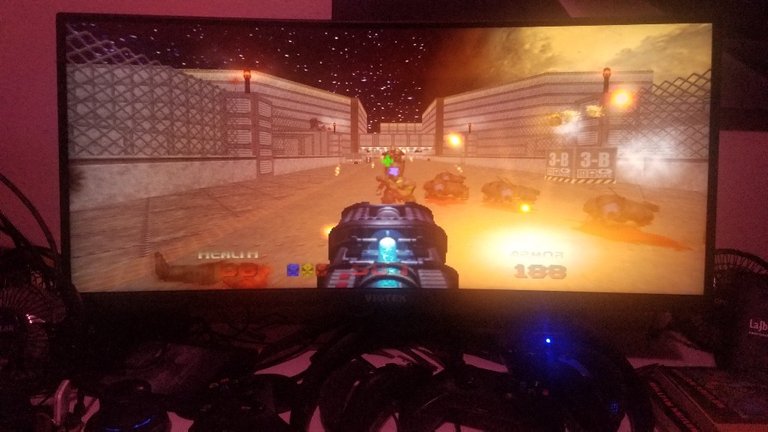
Growing up as an autistic boy in the 90s, computer games were my world. My father, a now retired computer engineer, always kept me furnished in the cutting edge of home computer components in the hopes I would take after him and pick up programming.
Instead what I did with this expensive gear (and PC stuff was indeed much more costly in the 90s than today) was to play games. Which hurt my grades, until the games were taken away, whereupon I improved my grades until I could get at the games again. They’d already dug their claws deep into me, even then.
Wolfenstein 3D is where it started. What a sensation! Where before computer games were 2D, often side scrolling affairs little more advanced than what you could play on 16 bit home consoles, here was a fully realized three dimensional false reality, rendered before my eyes by my own PC.
Those who did not live through the jump to 3D don’t fully appreciate what an impact it had. People went crazy for it. They scorned very beautiful and well made 2D games as obsolete, even SONY prevented their localization to the US because they made the Playstation look weak to US gamers.
I was under the same spell as everybody else. Gaming had suddenly transformed from a hobby and a fleeting distraction from bullying at school, into proper escapism with limitless potential. A false reality I could put myself into, where I had more control over my surroundings and was empowered to solve my problems.
Empowerment, in Wolfenstein 3D, meant guns. Likewise with Doom and Quake after it, the player is thrust into position behind a gun immediately upon entering the world. It’s inescapable, there is no option to play it any other way, being armed is natural and unavoidable in this genre. There is always a gun. If not a gun, then a sword, or some similar implement.
It represents many a priori assumptions that go unexamined by the player; that you are in a hostile world. That every one of your interactions will be combative in nature, every other character you encounter (even friendly ones, as in Strife) you will relate to as gunman to potential target. You are never, ever safe at any point and must remain constantly hypervigilant against threats both seen and unseen, which could strike from anywhere.
All often true in games but only rarely in real life. Not a very balanced, healthy view of things, but one which may sound familiar. It’s a very streamlined, gratifying perspective for a young socially alienated kid. The many complicated problems with the world all become simple to solve, and you’re handed the tool with which to solve them.
Besides the starting conditions of FPS games coloring how you relate to the world and other characters in it from the get-go, it also leads the player to make some assumptions of his or her own. Principally, that being equipped to perpetrate violence also qualifies you to decide who lives and who dies.
You’re pit against the forces of evil by the plot (whatever plot was nominally present, given the state of this genre in the 1990s) but in doing so, the game also implies you are fit to decide who and what is evil. The stakes are high, given that your only options for how to deal with potential dangers in FPS games are evasion, inaction, or violence. There’s not much of a gradient there.
The game world is a hostile, scary place. Almost everybody you meet will be a monster who cannot be negotiated or bargained with, only succumbed to or destroyed. You, by right of power, are the arbiter of virtue. If it doesn’t meet with your approval, it dies.
All of this is communicated to the player subconsciously, in an instant, from the moment they spawn in the first level with a little gun held out in front of them. Doubtless this wasn’t intentional; John Carmack is nobody’s idea of an aggro meathead. Nor Cliffy B, nor Michael Abrash, or Tim Sweeny, or any other important figures in the formative days of the FPS genre.
It’s all simply implicit in your sudden appearance in a game world you can only meaningfully interact with via weapons. Half Life and Half Life 2 mixed this up significantly with their in-game story telling and puzzles, but you were still an ostensibly heterosexual white guy with a gun going around shooting whoever you feel should stop existing.
Of course the events of the game are contrived such that you’re always justified, as with Wolfenstein 3D where you’re mowing down jackbooted Nazis, or Doom where your victims are the relentless, insatiable demons of Hell itself. But even within these worlds, designed in just such a way that violence is almost always the right solution, there are…”structural anomalies”.
Consider for example that there are no women in Doom 3, save for one who dies mere moments after you meet her (first Lost Soul encounter). Somehow in the process of colonizing Mars, the UAC managed to send exactly one woman, whose role in the game is to succumb to demonic forces and perish less than ten seconds from her first appearance onscreen.

still from Doom 3, by id software
There’s a female enemy. Doom 3’s Spider Queen, or as I affectionately refer to her, the titty spider. It is a fit, well proportioned nude woman’s upper body sprouting from a spider’s, like an insectoid centaur. Her face is repulsive, but it’s not her face that most of the polys went into.
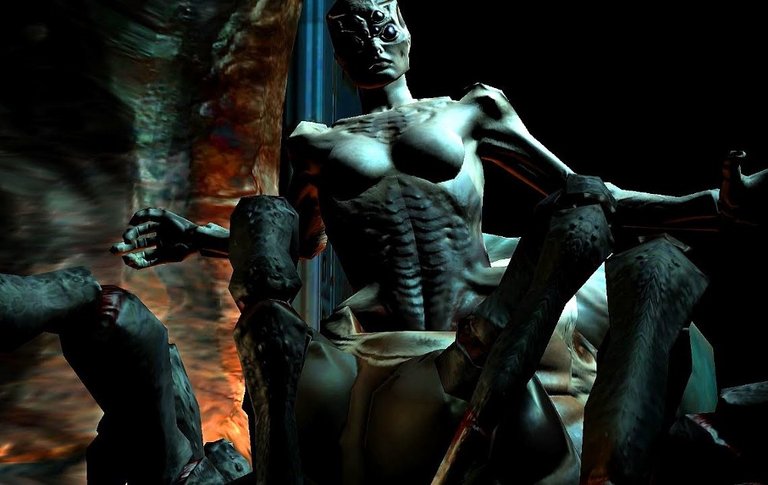
still from Doom 3, by id software
I’m not trying to get all Anita Sarkeesian here, but that is conspicuous. The expansion seemed somewhat self aware about the weird homoerotic, militaristic tone set by the first game wherein the world consists of industrially stamped cold sheet metal panels splattered by warm fresh blood, dimly lit corridors patrolled by ripped dudes who somehow comprise almost the entire population of Mars, all of them either soldiers or STEM professionals.
What I mean by self aware is that they included one woman character, a scientist, who gets extensive dialogue and a meaningful part to play in the story. That’s a welcome change, though she is dressed like this:
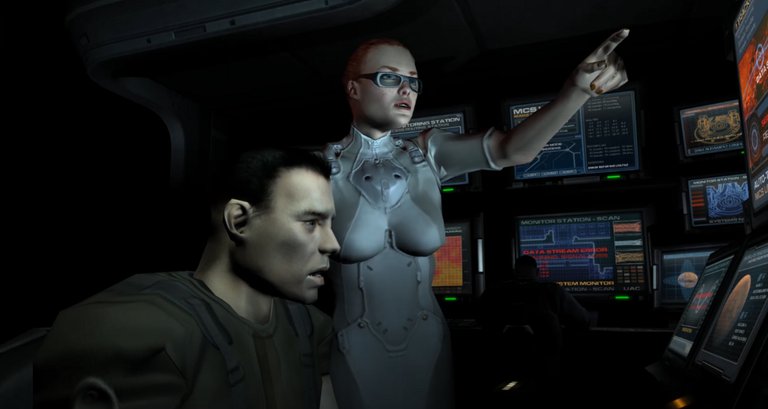
still from Doom 3, by id software
So, the one woman they added to disrupt the sausage party was a busty ginger in latex fetish gear. So reprehensible that I sometimes commission fan art of this character and save it to a hidden folder so that I can periodically view those images in order to remind myself how reprehensible it all is.
Why is she like that? No reason, she just happens to be the most qualified woman for the job according to UAC human resources, and her standard issue lab attire serves up her precisely outlined baps on a plate for all to admire. Probably not the most far fetched thing in a game about Hell invading Mars through teleporters, so let’s grant that conceit.
Women still exist in this game world initially only as victims. Not even as sexual wish fulfillment, the portion of the male ID being gratified here exists semi-independently of the libido; Beautiful women’s bodies are only garnishes to the main course of slaughter. They aren’t the porn, violence is.
This all resonated deeply with a bitter, disaffected young me, who then and now finds much about romance and sex confusing and complicated. There’s no confusing feelings in the game. Love isn’t complicated in a shooter, because there isn’t any. The world is a hostile, scary place inhabited almost entirely by menacing creatures who mean you harm, and you were put there to shoot them all.
There’s little room for women in such a world. For feeling, or tenderness. It’s all simplified away, like everything else. Turned into a problem you can either safely ignore or solve by shooting at it. This represents a tantalizing shortcut to fulfillment of one kind for young, emotionally unintelligent young men which does not require any sort of personal growth to attain. Just aggression, wit and reflexes, all things I possessed in abundance during that stage of life.
This weird, contrived representation of women in the shooter genre is exemplified perhaps most infamously by the hive scene in Duke Nukem Forever, wherein Duke finds nude women, all impeccably physically fit, all atypically top heavy, helplessly restrained in slimy green cocoons.
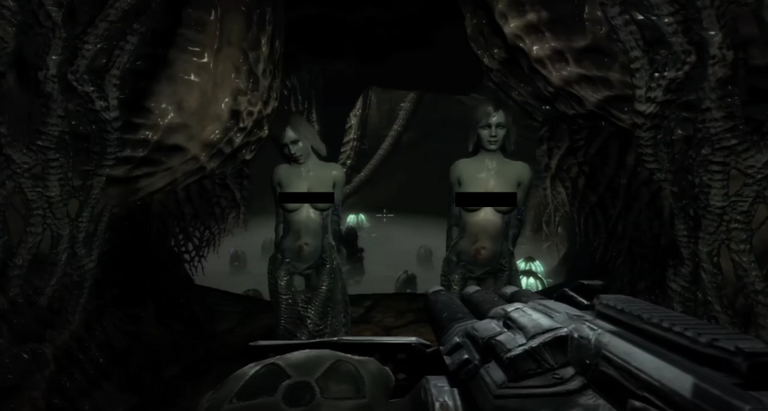
still from Duke Nukem Forever, by 3D Realms and Gearbox Software
They are there to be inseminated unwillingly by the grotesque, facehugger-like “Impregnators”. Or mercy killed by Duke. But not before admiring all the hard work that went into modeling and animating their glistening, damp, feebly writhing naked bodies. It was enough to make even staunch antifeminists raise an eyebrow at the devs. I myself began to feel seriously conflicted the third or fourth time I blasted rope to this part.
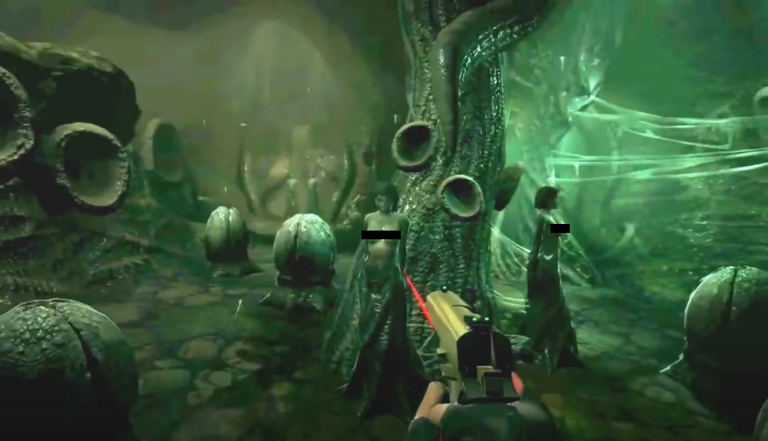
still from Duke Nukem Forever, by 3D Realms and Gearbox Software
It’s the same weird dynamic as in Doom 3 where women exist either to be ogled, ignored, or killed. It’s just a more over-the-top take on that MO. Which is at the artist’s discretion, being that DNF was a game specifically intended to be brutal, offensive and titillating. The devs were at least self aware about what they were creating and why.
Doom 3 is an interesting case to me because I don’t think the devs were self aware about the proprietary androcentric strangeness of the world they created which could have come only from the minds of men who grew up hunched over computers in dark rooms, exposed to the fairer sex primarily in centerfold or jpeg form.
They eventually became aware of the weirdness of an entire Mars base with no women except Ms. Diesatonce and Titty Spider some time between the publication of the first game and the second, probably not early on in development or we might’ve seen fully modeled and animated woman laborers, scientists, technicians and soldiers included.
That’s the anomaly I’m interested in. That they could create all of that without it ever once seeming uncanny or contrived to them. Having after all externalized a reality representative of their own psychological state during development, and likely since early adolescence.
To be fair, I don’t know these men personally, this is speculation on my part. Although none of it seemed weird to teenage me either, who didn’t ever examine why I was like that any more than any other teenage boy, or a great many adult men, some of whom make computer games. I had the same luxury they did, living in an expensive technological bubble of false reality that unwelcome confusions like nuance and feeling could not intrude upon.
Compound this effect when I discovered level editing. What an incredible sensation of freedom, to realize all my fantastical dream scenarios in a (then) convincing interactive 3D world! I’d been taught level editing at a Summer camp run by the local science museum.
They had some very expensive and normally hard to get at VR gear available to students of their Summer game dev program wherein we would learn to edit levels for Duke Nukem 3D and Quake, then virtually inhabit them by way of ungainly 1990s VR headgear called the Forte VFX-1, which rendered these worlds we created at 263 x 230 resolution, in 256 colors, at perhaps thirty frames per second.
But of course no matter what beautiful and interesting world we might create, once we actually stepped into it and began playing, there was the gun in the player’s hands. Always present, a constant reminder you’re in danger, you’re here to kill or be killed.
I think this is when I first properly noticed the weirdness of the gun always being there. I didn’t want it to be in some maps, like recreations of my home or school. I recognized then that I didn’t always enjoy aggression. That in fact, most of the time I don’t. The gun just wouldn’t go away. Always there in the edge of my vision, waiting, begging to be used on anything.
I made what could be regarded as primitive walking simulators. Maps with no enemies in which the only purpose was either to admire the architecture or to solve puzzles. To prevent a reactor from melting down in one map, saving lives rather than ending them.
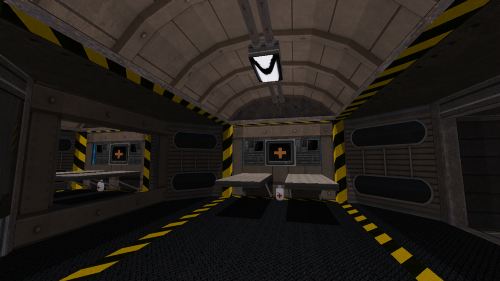

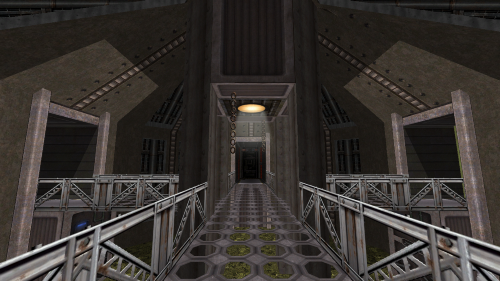
Some of my level editing handiwork, gun removed
These met with poor reviews which praised the intricate architecture but questioned what the point of it was without enemies to shoot. Somebody asked if I’d simply forgotten to put any in before I submitted the map for review. This was many years before the likes of Dear Esther made walking simulators a thing that people voluntarily sought out on their own merits.
So I put monsters into the next map, and all the others after that. I’d disable them when playing it myself as I just wanted to admire my own handiwork. The monsters and guns and other nonsense just got in the way of what I loved about creating game environments to begin with.
I turned to making deathmatch levels in part because they were almost purely architectural. Consideration had to be given to item placement, level flow, etc. but there were no monsters. DM levels were like pristine cathedrals, forever immaculate monuments to the level editing prowess of their designers.
These beautiful abstract places are where I spent many a sleepless night, fragging buddies from school. Two or three energy drinks in, my pupils wide as dinner plates. My heart throbbing like a hummingbird as my overclocked brain tracks multiple moving targets, dispatching them with quickly but precisely placed instagib beams. They explode in rapid succession, each blossoming into a fireworks display of rich, red viscera.
It feels something like what I imagine hunting is like for cats. A very complex brain normally, suddenly narrowed in scope, fixated on the goals of hunting and killing. Everything else goes away. All your problems, all your confusion and anxiety about your changing body, your budding romantic feelings. All of that goes on a shelf while you practice efficiently tracking and dispatching targets in a harsh, zero-sum bloodsport.
In many respects this is even more hopeless and dismal a world than the single player campaigns could offer. A world where death is constant but impermanent, robbed of all meaning. Where the universal language is gunplay. If players speak to one another, it’s to talk trash. More garnishes for the main course of red, quivering meat, recently separated from the bone by way of railgun.
Thus, instead of mindless monsters and mutants, I was pit against other boys. Flesh and blood, sensitive, living and feeling little humans like me. They were mostly boys then, due in part to our frosty reception to girls intruding into a hobby we used in large part to escape from them. But, as someone alive to see it then, girls were largely disinterested in gaming until the stigma of videogames being a thing for lonely nerds faded away by the mid-2000s.
Anybody who did want in, prior to then, had a hard time of it. Even other males had to jump through hoops, kiss ass and form alliances to establish themselves, as occurs anywhere more than two primates are gathered for any length of time. It was an even less welcoming, supportive environment if on top of being a noob, you were also double X chromo.
This situation was arguably even worse for my emotional development. I might’ve learned something, talking to those other boys. About them, but also myself. There’s just little time to bare your soul to strangers when you’re dodging rockets. Instead my after-school escape closely resembled an even harsher version of the pecking order at school I played games to escape from.
You have to be perfect all the time or die trying. Aware of every possible threat and every possible direction it might come at you from. As if I wasn’t already anxious. You’re explicitly ranked by K/D ratio at the end of every match so everybody can see who made the cut and who wasn’t good enough. It’s like middle school P.E. dodgeball, but with explosions and more blood than usual.
The saving grace was that here, I was finally recognized and rewarded for something I was good at. Where at school I was constantly found wanting, because it was a different sort of proficiency I was being evaluated on in that case.
So I turned away from reality, delving instead into fantasy. A choice everybody makes at some point. An easy one for me, which I never looked back from despite the ironic folly of escaping a world of elitism and recreational cruelty for an artificial world of elitism and recreational cruelty, just because I ranked higher in one than the other.
Understandably there was some glimmer of recognition in grey haired politicians that raising a generation of kids on these games might not result in well adjusted adults. But gamers, fiercely protective of their sorely needed escapism, fought back with infectious ridicule that eventually settled the matter of violent videogames in the court of public opinion: It was much ado about nothing.
While it’s certainly true that there’s no concrete causal link between playing violent videogames and committing real world violent acts (a canard that was and is absolutely as ridiculous as skeptics made it out to be) we are nevertheless influenced in many ways, some of which we’re not consciously aware of, by the media we consume.
It’s kosher to say that watching the news all the time will make you a nervous wreck because they disproportionately report the bad in the world. But suggest that design choices in a popular genre of games warps the still-forming worldview of young, disaffected teens and out come the keyboard warriors to defend their hobby (and mine), accusing you of being a pearl clutching neopuritan.
I don’t think violent depictions in media should be banned, or censored. I generally think banning stuff is a last resort, not the first resort it’s often treated as by people whose only tool is a hammer, such that all the problems in the world appear like nails.
What I do think is that the stimuli you surround yourself with, day in, day out, exert a sculpting influence on you. On your mindset, how you conceive of yourself, the world, and how one relates to the other. What is your personality after all but accumulated experience? Sensory intake recorded as memories which alter and inform how you interact with the world going forward.
A conscious mind is a sponge, always absorbing whatever information is around it. Surround yourself with upbeat, encouraging, bright and colorful art/music/movies/games when you’re down, and it’s likely to improve your mood.
But surround yourself with negative, drab, dreary things, even if your life is going well and you have no reason to despair, pretty soon you may notice it beginning to drag you down. This is not really saying anything other than humans are suggestible creatures and that not all influences shaping us are doing so at the conscious level.
I noticed this when I began to write fiction. It was soon pointed out to me that none of my stories had happy endings. They always ended with the protagonist discovering that not only are they doomed, they were from the start, having realized too late.
A good 90% of my oeuvre is horror, probably non-coincidentally. A hobby which can be genuinely social and cathartic had instead, for me, reinforced everything wrong with how I viewed myself and the world. Rewarding me for it, positioning aggression as the solution to all life’s problems, with complexity and nuance being either illusory or irrelevant.
The virtual worlds I spent much of my youth in furnish some clue as to how my psyche became so cluttered with monsters hiding in every shadow. They were all either sterile futuristic space stations, drab soulless industrial facilities or bleak, menacing dungeons and abbotoirs.
Not the best places for a tender developing lad to learn lessons about empathy, self-restraint, social consideration and romance. You’ll learn only one kind of lesson here. It’s that life is pain, to exist is to fight, and the only way out is through. Potentially valuable lessons in the right context, but not presented alone, absent anything uplifting, on a never-ending loop.
I just didn’t think there was anything odd about my affinity for bursting chainsaw toting ogres into fountains of gore in dark subterranean tunnels, condemned factories or Eldritch lairs. All the games I played were like that. Hopeless hellscapes unfit for any purpose except as a backdrop against which to slaughter nightmare creatures for the sin of existing within my field of view.
The escapism furnished by ever-advancing 3D games was undoubtedly much appreciated by teenage me and many others in the same emotional and social position I was at that time. That said, for the reasons outlined above, it probably didn’t help my feelings of alienation by pitting me against the entire world in a fight to the death over and over.
I will say I’ve never committed an act of actual physical violence against any other person. From that angle, if I mean to argue that constant exposure to violent computer generated empowerment fantasies produces adults who are a danger to others, I’m doing a poor job by admitting my pacifism. But you can be maladjusted without necessarily being dangerous to anybody, save perhaps yourself.
This is all without even touching the subject of movies, which deserves its own article and will likely get it soon. But the 80s and 90s furnished no shortage of film plots wherein a burly, well armed man stands alone against a scary, dangerous, corrupted world filled with menacing ghouls.
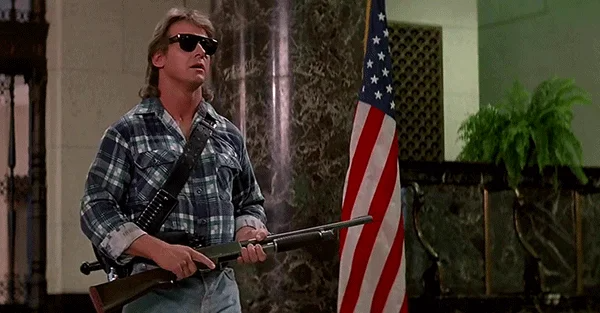
still from “They Live”
They Live. Aliens. Rambo. Terminator, in particular the Future War. Basically any Stallone or Schwarzenegger flick from that era. Alien and Aliens differed primarily in that the hands holding the gun in our POV for once belonged to a woman. Still fundamentally the same formula though: Dark and scary world, lone gunman assumes sole responsibility to decide what is right and impose it by force, usually involving a substantial body count.
Besides movies, there’s significant overlap between appreciators of this genre and various kinds of metal. Death metal, black metal, speed metal, etc. Not as a causal factor, again, but as yet more grim and brutal art glorifying fire, hatred and speed, which someone already in that headspace might surround themselves with.
In doing so, inadvertently reinforcing and perpetuating the mindset that they’re alone in this life with the odds stacked against them, beset upon all sides by enemies and damned from the start, with no choice but to wage a one man war on the world.
I’ve not gotten into it until now but perhaps you can see how someone with this mentality could show up to a protest with a firearm, thinking that will improve the situation. Or seize a city block and declare it a lawless zone, or riot at the capitol thinking there will be no consequences because you’re the main character.
After all, you’re doing what you’re supposed to, standing up for what is right against what seem to you like inhuman enemies. Everybody fighting you is just there for you to defeat on your way to a well earned reward and accolades for being the hero of the story.
This also furnishes some possible glimpse into the minds of school shooters, overwhelmingly young white males from middle or upper middle class homes. To be clear I don’t think you can establish a clear causal radicalization pipeline for school shooters that includes violent games as a necessary component, but it’s conspicuous how often they’re present in the shooter’s life. Eric and Dylan’s Doom wad based on their school for example.
Rather than being what motivated the violence I suspect they’re more of a symptom/comorbidity. The same real life stresses that motivated their atrocities were likely what they used computer games to escape from. Their choice of games influenced by what they were already feeling, rather than the reverse.
Right up to the line where actual violence occurs, there is little in the popular culture to tell aggressive, alienated young men that they’re on the wrong path. They live in a country with a rich and storied history of military adventurism. A military which at one time actually produced its own FPS game as a recruitment tool.
Admonitions to gentleness, humility and common humanity ring hollow when you read in the news that the president sent a fleet of drones to blow up a wedding because somebody in attendance was on their shit list. Which president do I mean? Take your pick.
There’s a highly visible exemplar of individual success using violence to solve problems with great success, the collateral cost one of those irrelevant confusions to be put on a shelf. What works for successful men must surely be the right answer to life’s problems?
This is a very old sales pitch that in recent years has found an increasing number of takers. A movement now, which we’ve not heard the last of. Men (and no small number of women) who feel that capacity for violence is still a core component of male identity and value, though in the modern world there exist vanishingly few circumstances where violence can be employed constructively (except to stop other violent dudes).
This all comes from a heterosexual, white American man, if any of those criteria are important to you. Someone who has frequently been an outspoken critic of critical theory and social justice because of their actual neopuritanism. Even so, this article may still be misunderstood by some as an attack on masculinity.
I emphatically do not mean it that way, as someone from much the same background as the kind of reply guys who usually interpret pieces like this as anti-male. Men are not only hunters or warriors. We are poets, scientists, explorers. Fathers, brothers, sons and husbands.
In truth, these are the roles we’re greatest in. Interacting with the world by creating, rather than destroying. Looking our fellow humans in the eyes, not through iron sights. We still have a vital role to play as protectors, but not as aggressors.
Keeping the world at a comfortable distance, ready to attack every approaching stranger at a moment’s notice should our fears be vindicated, seems wise in the moment until you discover how alone it has made you, inside and out. Is your specific corner of the world really that nightmarish? Is that how you want to experience the remainder of your life?
The world is not that scary, for those of you reading this on computers or smartphones, from within apartments or houses in the first world anyway. True, 2020 has been a rough year. Covid, riots, and we collectively discovered that viral 3D gorilla lamp isn’t even really 3D. But statistically speaking we live in an age of unprecedented abundance, convenience and comfort. What we call poverty in the first world is a standard of living that wasn’t even available to royalty in the middle ages.
Truly, not everybody is out to get you. You’re not even on most people’s radar. They will mostly come at you the way you come at them. If you offer an olive branch, it may be rebuffed, but it may be accepted. If you offer a fist though, you’ll never get an olive branch in return, only another fist. One of those approaches has more possible outcomes than the other.
I have thought at length about how to rehabilitate myself, rinsing out the accumulated grime of twenty years worth of bad vibes. Certainly I wrote much of my horror as self-therapy, to get all that stuff on the outside into the purifying sunshine rather than let it forever fester in the dark, dusty, cobwebbed corners of my mind.
I still keep coming back to that stuff, though. I grew up with it, I associate it with fond memories of fun with my friends as a boy. It’s part of me now, for better or worse it’s simply what I enjoy. I still play on Hardcore in Brutal Doom or Nightmare in Quake 1 now and again, wanting for some reason to punish and be punished.
Gore still provokes in me some degree of lurid excitement. I still feel a nameless attraction to industrial decay. To the naked concrete forms of brutalist architecture. To barren, hopeless places like Antarctica or the abyssal plain. That’s still where I live, in my heart. But you don’t need to. I can never fully leave this place behind. But if you’re young, you still can.
I take my slumber now. To dream, as I often do, of stuff best confined to dreams: Endless networks of cement corridors lit by flickering bulbs. Things-that-wait perched in high out of the way crevices, patiently surveilling the section below for passing meat. My little cat has also become insistent that we retire to bed. Whereupon, being a cat, she will also most likely dream of violence.
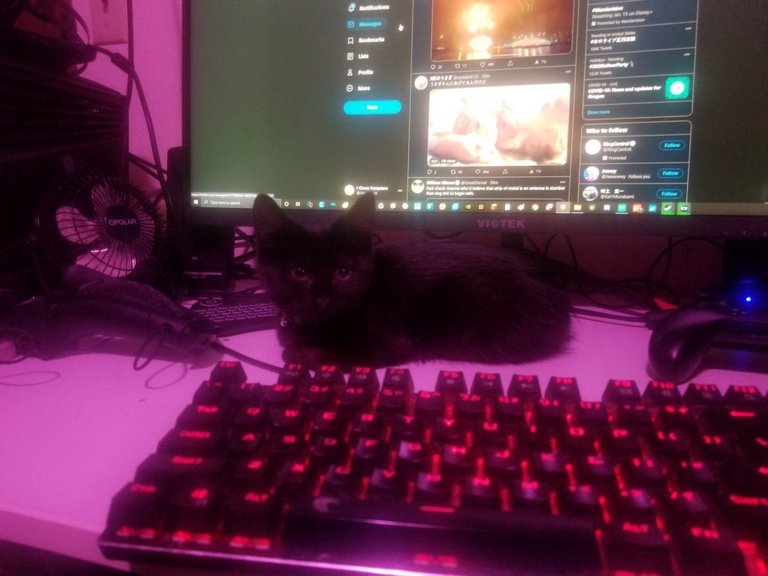
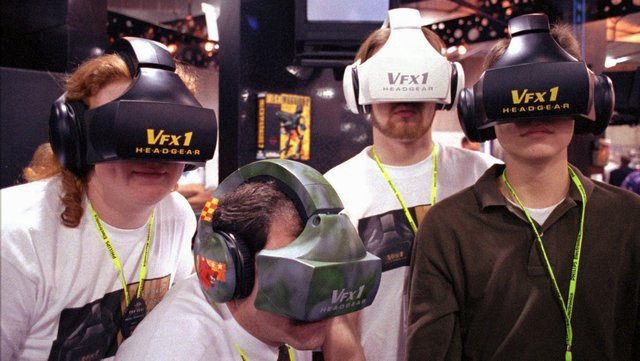
Hi alexbeyman,
Visit curiehive.com or join the Curie Discord community to learn more.